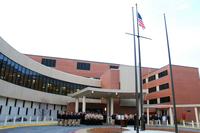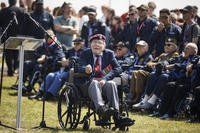Some U.S. Air Force units have instituted a buddy system that groups individuals into cohorts or "pods" as the service attempts to stave off the spread of the novel coronavirus, officials say.
Airmen at Sheppard Air Force Base, Texas, for example, have begun implementing the containment strategy, known as a "ring-one cadre." It groups together airmen who would normally commingle on a day-to-day basis, explained Col. Kenyon Bell, installation commander and head of the 82nd Training Wing.
"This has been an evolution," Bell said in an interview Tuesday. "Each time we start to formalize our containment strategy and move down how we minimize exposure, it evolves."
His comments came after photos sent to Military.com last week showed airmen with the 82nd walking around the base closely together even as top officials, including Defense Secretary Mark Esper, stressed that troops should strictly follow the Centers of Disease Control guidance to stay six feet or more apart whenever possible.
Related: The Pentagon Says Troops Are Social Distancing. Why Do These Photos Say Otherwise?
Families of airmen attending the training raised concerns in a private Facebook group and began pressing base officials, asking whether leaders were ignoring the call for social distancing.
During a Facebook Live video chat Friday, Bell explained the new system, calling it "a ring-one cadre of people," or those airmen who interact the most with each other on duty. Bell said the groups in his office, for example, have split up in order to avoid unnecessarily bringing in other airmen.
"We need to physically distance ourselves as much as practical," he said Tuesday. "When we're marching around, yes, we can break down into smaller groups."
But if, for instance, Bell came down with COVID-19 symptoms and had to quarantine for 14 days, his cohort office buddies "would do the exact same thing," he said.
The commander said he's been calling the system "physical distancing" instead of "social distancing" because airmen are still encouraged to keep social connection during this difficult time.
"The part that I think a lot of people have a hard time grappling with is, when we're in a training environment, there are some cases that you just cannot physically stay six feet apart from each other and accomplish our mission," Bell said. He gave the example of trainees changing an aircraft tire, which is a two-person job, at least.
"Since we have been deemed essential to the mission, and we have to accomplish that training, then we accept some risk in that area," he said.
Sheppard is home to the largest technical training wing in the Air Force, producing roughly 65,000 graduates annually, according to a fact sheet provided to Military.com. At any given time, there are between 4,500 and 5,000 technical trainees at Sheppard, assigned to six training squadrons. Trainees span more than 60 Air Force specialties in the aircraft maintenance, logistics and civil engineering career fields, the service said.
The ring-one concept is not completely regimented. A commander who oversees 1,000 people isn't picking which airmen stay within a specific 10-person group, nor are they assigning airmen to groups, Bell said. That happens as a natural progression to keep a "small ring-one [group] as possible," he added.
Bell imposed a restricted movement order March 20 for the 5,000 trainees living on base.
"It's been several decades since I've been 18 years old, and now [they are] confined to a space of a 16-mile fence line to live, work and play for an indefinite period of time. So, as you can imagine, there's some frustration, there's some restlessness," he said. "But at the same time, by and large, we have made a tremendous effort to educate people on why we do it."
Grouping Shift Work
The 80th Flying Training Wing, which has 350 student pilots at any given time, shares Sheppard with the 82nd. While the 82nd has strictly limited its trainees' movement, the 80th doesn't have the same luxury, since some of its personnel -- including international student pilots -- live off base.
Col. Russell Driggers, 80th commander, has divided his airmen into what he called "pods" -- as small as six to seven airmen -- in addition to moving airmen around in "blue and silver" shifts to bring them on duty during very specific times. Driggers said that all training is done within the assigned pods, which are rotated -- one week on and one week off -- to further mitigate the possibility of interaction.
Unlike the 82nd -- which has courses that last anywhere from one month to more than seven months, depending on specialty -- flight training students come in for roughly a one-year curriculum. The base has not accepted any new international students since Esper issued a stop-movement order last month, but students are free to leave "if those nations will accept travel from the United States," Driggers said.
Air Combat Command units are also aggressively using a shift-like model, said spokeswoman Leah Garton.
Maintenance personnel with the 1st Fighter Wing at Langley Air Force Base, Virginia, have split work "into team A-and-B shifts alternating daily or weekly to minimize potential exposure," Garton said.
"Personnel on each shift are required to sanitize their equipment prior to shift turnover," she said in an email. "Crew chiefs sterilize high-maintenance personnel contact zones in and around cockpits and throughout maintenance work areas."
Meanwhile, 20th Fighter Wing squadrons at Shaw Air Force Base, South Carolina, have been divided into two teams with alternating flying schedules.
Pilots and maintainers use rapid crew swaps and hot-pit refueling "to increase sortie generation while decreasing the amount of times maintenance personnel have to interact with the jet," Garton said.
The examples listed illustrate the dynamics happening at each base around the country amid the coronavirus outbreak, Bell said.
One-Size-Fits-All 'Doomed to Fail'
Sheppard has had at least two confirmed COVID-19 cases on the installation: a member of the 80th and an employee at the base Starbucks. The base no longer publicizes confirmed cases following a Pentagon order to stop doing so at the base level in order to preserve operational security measures.
"I share the concerns and hear them frequently from family members, who are chiming in and asking about, 'Hey, what's happening with my son, daughter, grandson, granddaughter?'" Bell said. "Again, we're trying to offer that separation and minimize exposure, and there are lots of efforts that are going on across the installation that will help us prevent the spread."
Last week, when asked whether the Air Force would require all bases to institute the same specific protocols to protect airmen, Chief of Staff Gen. David Goldfein emphasized that commanders have to do what makes sense for their units.
"Local commanders at the installation level have got the most situational awareness," he told reporters during a Mitchell Institute "Aerospace Nation" chat April 1. "Tinker Air Force Base in Oklahoma doesn't look like Kunsan [Air Base, South Korea], which doesn't look like Ramstein [Air Base, Germany]," he said.
Goldfein said he was not surprised to learn of the pod structures happening at Sheppard, which he said is likely happening at other units, too.
"If my job is nuclear security, and I'm going out to the missile fields, it wouldn't surprise me at all that that squadron is hanging pretty tough and tight together because they're having to operate in that unique environment," the chief said. "A one-size-fits-all approach to every installation is doomed to fail.
"Again, the individual who has the most situational awareness who is making the smartest, most thoughtful decisions are those installation commanders," Goldfein said. "We expect [them] to lead the way, and we tell them, 'Don't wait for us. Operate within the bounds that we've set and move out.'"
-- Oriana Pawlyk can be reached at oriana.pawlyk@military.com. Follow her on Twitter at @Oriana0214.
Read more: A-10 Makes Emergency Belly Landing at Moody Air Force Base












